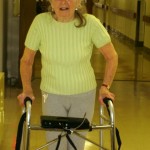Designers: Nancy Du and Shawn George
Client Coordinator: Linda Cates, PT, Duke University Medical Center
INTRODUCTION
Users of rolling walkers who have Parkinson’s disease sometimes experience “freezing of gait” episodes in which a loss of balance causes serious injury when operating a walker. Inability to break the freeze and the consequent “leaning forward” posture causes the user to fall facedown as the walker rolls away. Visual cues such as a laser line have proved successful in aiding to break a freeze, but currently available products require the voluntary activation by the patient. We developed a device that constantly monitors the patient’s position behind the walker, and automatically activates visual and vibrational stimuli to help the user break a freeze. Additionally, our device can be used to prompt all users of rolling walkers to maintain correct posture and position. Initial trials at a rehabilitation clinic have been met with enthusiasm.
SUMMARY OF IMPACT
Elderly individuals who use rolling walkers tend to “drift” from their walker and often require constant oversight by their therapist or caregiver, and this device serves as a preventive measure to remind the user to step forward and regain proper position behind their walker. The vibrational cue allowed the user to focus their gaze ahead without having to look at the floor for a laser light. Linda Cates, PT, the client coordinator, said that this device will be of great benefit to people with Parkinson’s disease who experience freezing of gait.
TECHNICAL DESCRIPTION
A Sharp GP2D12 infrared distance sensor, with the ability to measure from 10-80 cm at an accuracy of ±1 cm, continuously measures the distance between the torso and front of the walker and outputs this to a Basic Stamp 2 (BS2) microcontroller chip (Parallax, Inc., Rocklin CA). This distance is compared every 50ms to a “threshold” distance, which is set by the clinician and represents the upper limit of the “safe-zone.” When the measured distance exceeds the threshold, it is highly probable that the patient has frozen and/or is dangerously far away from the walker. The BS2 then activates external cues to remind the user to take a step closer, thus aiding the patient to break a freeze and regain proper position behind the walker.
One of the external cues is a horizontal laser light beamed on the ground in front of the patient’s feet to remind them to take a step. In addition, vibrating (pager) motors, sheathed in pads attached to the handles of the walker, are also used. This allows the patient to feel a tactile prompt when they should be taking a step, which is a more comfortable alternative for patients who prefer to focus their gaze on the path ahead instead of at the ground.
The clinician or user may set the threshold distance on the device by turning a knob attached to a potentiometer. The threshold distance (in cm) can be read on the LCD display of the device. The LCD also displays the distance being read from the distance sensor and instructs the user to “move away” when they are too close and to “step closer” when they are starting to get too far. Switches allow the user to choose between the laser cue and/or vibratory cue, in case one of the cues works better than the other. Diagnostic switches are used for testing and calibration of the laser and the motors, which allows the therapist to adjust the laser light position accordingly to the patient, and allows the patient to initially gain a sense of what the vibrational motors feel like. All components, except for the laser, were enclosed in a low-profile custom built box which mounts quickly and securely to the walker using bicycle light mounts.
The device has been designed to remain on continually. This was done to ensure that the user would not inadvertently forget to turn the device on. When the user steps away from the device, the walker monitor enters a low power “sleep” mode. When in sleep mode, the device will briefly wake up and read the sensor every four seconds to see if there is an individual in front of the device. When a patient is detected in front of the walker again, the device will turn return to operational mode, scanning every 50ms. This energy efficient function enables a battery life of more than three days when fully charged. A rechargeable, 7.4V Lithium-ion battery is used to power the device, and can be recharged by plugging in a detachable battery charger which also disconnects the main circuit from the battery during charging. A ‘low battery’ LED prevents from over-discharge of the battery, reminding the user to plug in the charger.
The cost of parts/materials was about $377.22




University Operator: (919) 962-2211 | © 2024 The University of North Carolina at Chapel Hill |